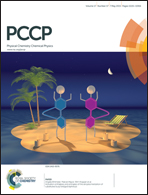Bipolar doping of double-layer graphene vertical heterostructures with hydrogenated boron nitride†
Abstract
Using first-principles calculations, we examined the bipolar doping of double-layer graphene vertical heterostructures, which are constructed by hydrogenated boron nitride (BN) sheets sandwiched into two parallel graphene monolayers. The built-in potential difference in hydrogenated BN breaks the interlayer symmetry, resulting in the p- and n-type doping of two graphene layers at 0.83 and −0.8 eV, respectively. By tuning the interlayer spacing between the graphene and hydrogenated BN, the interfacial dipole and screening charge distribution can be significantly affected, which produces large modulations in band alignments, doping levels and tunnel barriers. Furthermore, we present an analytical model to predicate the doping level as a function of the average interlayer spacing. With large interlayer spacings, the “pillow effect” (Pauli repulsion at the highly charge overlapped interface) is diminished and the calculated Dirac point shifts are in good accordance with our prediction models. Our investigations suggest that this double-layer graphene heterostructures constructed using two-dimensional Janus anisotropic materials offer exciting opportunities for developing novel nanoscale optoelectronic and electronic devices.


 Please wait while we load your content...
Please wait while we load your content...